Breaking Down Silos - Enhancing Digital Delivery for ESFA's Funding Service
Published on
How we’re reshaping Digital teams to improve collaboration, flexibility, and whole service delivery.
Published on
How we’re reshaping Digital teams to improve collaboration, flexibility, and whole service delivery.
Published on
The post on Mission-Driven Government highlights the growing momentum and opportunity to rethink service delivery in government. It also highlights the need to be pragmatic and start with the things we can control; this post explores how we are putting that into action.
This year, the ESFA’s Funding Service will distribute over £76 billion to 25,000 providers across the education and skills sector. When I joined the service to lead the digital teams just over 12 months ago, I was asked this question by CDDO…
How have you broken down silos, set up multidisciplinary teams, and reoriented delivery to focus on outcomes, user needs, and continuous improvement?
There’s still a lot of work to do, but this post goes through what the team have achieved over the last 12-months.
6 years of investment in digital systems meant the service could collect and manage data, calculate and publish allocations, issue contracts, and provide education providers with online access to their funding details and calculations. The digital teams were organically formed around existing business processes, with each operational delivery team having a digital team to build, run and maintain the technology used to support delivery.
This made it difficult for us to align service wide tasks like onboarding new grants to each of the systems and to tackle service wide problems like how we better communicate funding decisions. The siloed product delivery approach also led to inconsistencies across the suite of products and meant we had numerous single points of failure or product experts embedded in each team. This meant that people interacting with the digital teams or wishing to discuss new funding streams needed to speak to, align and plan work with multiple people.
From a planning perspective it was also difficult to take a service view and therefore difficult to make sure we were prioritising the right work. It was also hard for us to clearly define the cost to run vs our spend on improvement work as each product team carried out a mixture of both in each sprint.
Finally, the team had a heavy reliance on suppliers, particularly in decision making roles. All these things combined made it difficult to design or deliver a complete service, including handover points and interactions or tasks that fell between systems.
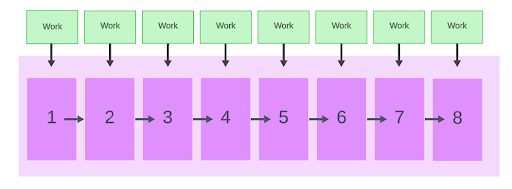
These challenges highlighted the need for a more flexible team structure allowing us to adopt a service approach to problem-solving and prioritising work, and for more integration across the core delivery teams, reducing single points of knowledge and simplifying working relationships with the teams we support
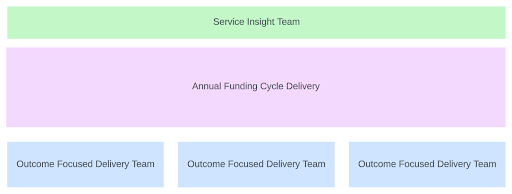
The service insight team will be able to carry out research outside of product teams and away from the constraints of what already exists. This will allow them to quickly adapt to emerging priorities or new requests. The small team will take a service wide approach focussing on the needs of our internal and external users, moving us from validating designs or solutions to making more informed decisions about what we need to design and deliver.
The outcome focussed teams will allow us to start to tackle some of the known problems that don’t fit neatly into any of the product teams. By funding teams and not specific projects or systems we are able to focus on outcomes and adding value, giving us more flexibility to react or change based on what we learn. These teams also help us to more clearly define value add and improvement work vs the regular running and refining of the funding service systems. To start we set up two teams to run two discoveries. One looking into how we could more efficiently and effectively communicate funding decisions and one looking at how we could enable the teams to onboard more grants to the service.
Finally we brought the service delivery teams closer together by pairing product teams under single product and delivery managers. Our digital form builder used to collect information from providers was paired with the data management system giving us better oversight of the data we collect and how it is used across the service. We combined the two teams responsible for the front stage or provider facing part of the service enabling them to take ownership of the full provider experience. Finally, we paired our complex calculation system with the contracting and payment system. This was done in line with our ambition to utilise domain driven design, as the two oldest systems in the service they had duplicated calculation and data handling functionality that we wanted to reduce over time.
As a side note over the 12-month period we also stopped 2 pieces of work to allow us to more clearly define the benefits and alignment to longer term goals.
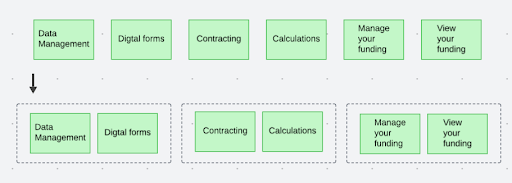
The new structure aims to remove single points of knowledge, reduce entry points for work and simplify how we interact with our stakeholders. It will also help us to more clearly define and cost business as usual delivery away from improvement work. Overall, our aim is to enhance collaboration and flexibility whilst increasing the efficiency of digital delivery.
With the structure in place we then need to design how work flows through those teams. The team currently uses scaled agile and comes together to plan in 3-month increments. I’ve never been a huge fan of SAFe but I could see how this was needed when we had 8 product teams with huge dependency on each other to deliver the annual funding cycle.
The issue is working this way incentivises each team to fill their 3-month block with work but it doesn’t facilitate service wide prioritisation meaning we may not always be working on the most important things. To address this, we started to introduce goals for each PI aligned to our four strategic objectives:
This was the first step towards making sure all the work we do is aligned with the service strategy and not systems or features. After that we introduced a simple form to capture all the asks of the digital teams. This stops work going directly to product managers in each team and creates a standard and fair way for requests to be evaluated. This process prevents us from duplicating effort across teams and allows us to introduce service level prioritisation. It also helps us to start changing how work is framed, moving requests from solutions to build to problems to be solved.
As well as handling requests for work from policy or operational colleagues we also need to integrate feedback loops at both product and service level. The insight team will support this by managing a recurring external provider survey and will also implement a similar survey for internal users. They will also carry out user research and analyse existing data from our error and near miss logs to help identify the next areas of focus for our outcome teams.
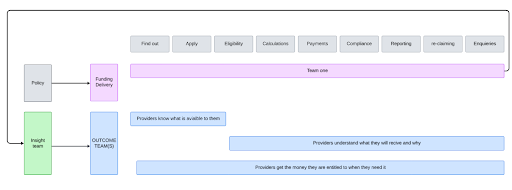
Once the teams are settled into the new structures, we plan to review the PI planning process and explore ways to bring together the yearly funding milestones and tasks with our existing agile methods.
Our starting team was heavily weighted towards product owners with no UCD leadership and a reliance on managed services for key planning and decision-making roles. To address this, we needed to grow the team and diversify our in house skill sets.
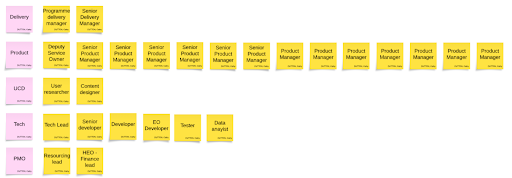
My Civil Service career to date has mostly been about growing design capability by hiring content, interaction and service designers as well as user researchers. This past year though things have been more difficult, the focus is very much on reducing headcount and spend. Despite this, to focus our delivery teams on outcomes, user needs, and continuous improvement we needed to have expertise in a range of professions. We also need to provide people with opportunities to learn and develop and to experience different types of delivery or different phases of projects.
Our new team structure helps with providing more opportunities, giving people the chance to work on critical live services as well as discovery and alpha projects. Bringing the core delivery teams closer together also enables people to move teams more freely gaining experience across the whole service.
To start to grow our in-house capabilities we first designed our team of the future. Our aim is to have at least 1 senior and 1 more junior role in every profession to give us greater resilience, clear career progression routes and more assurance over the work of suppliers. In key decision and oversight roles like delivery and product management we will have more roles enabling us to take responsibility for delivery and to shape what we do and how we do it. For similar reasons we also decided to make the insight team civil servants only, giving us much more autonomy over our long-term direction.
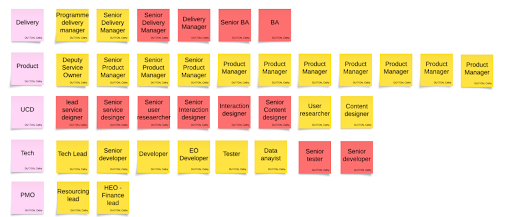
Over the last 12-months we have increased the coverage of UCD roles by hiring a lead and senior service designer and a senior user researcher. We have also added 2 new delivery managers with more roles planned for 2025.
Our primary mission is the seamless delivery of the annual funding cycle, a critical responsibility that consumes nearly all of our resources. Because of that, shifting our delivery to be outcome focused and centered around user needs and continuous improvement has been slow. We have also had to contend with working through a period of downsizing rather than growth. To tackle this, we’ve adopted a staged approach making efficiencies wherever we can to re-invest in more strategic goals.
Everything discussed in this post is about the digital teams and how we are evolving, but there is so much more to delivery then the digital side of things. Outside of digital our funding policy implementation (FPI) team are working up front with Policy to streamline the delivery of grants. We also have a collaborative project with FPI to explore how we can design grants that are simpler to operationalise or more consistent allowing us to utilise reusable service patterns.